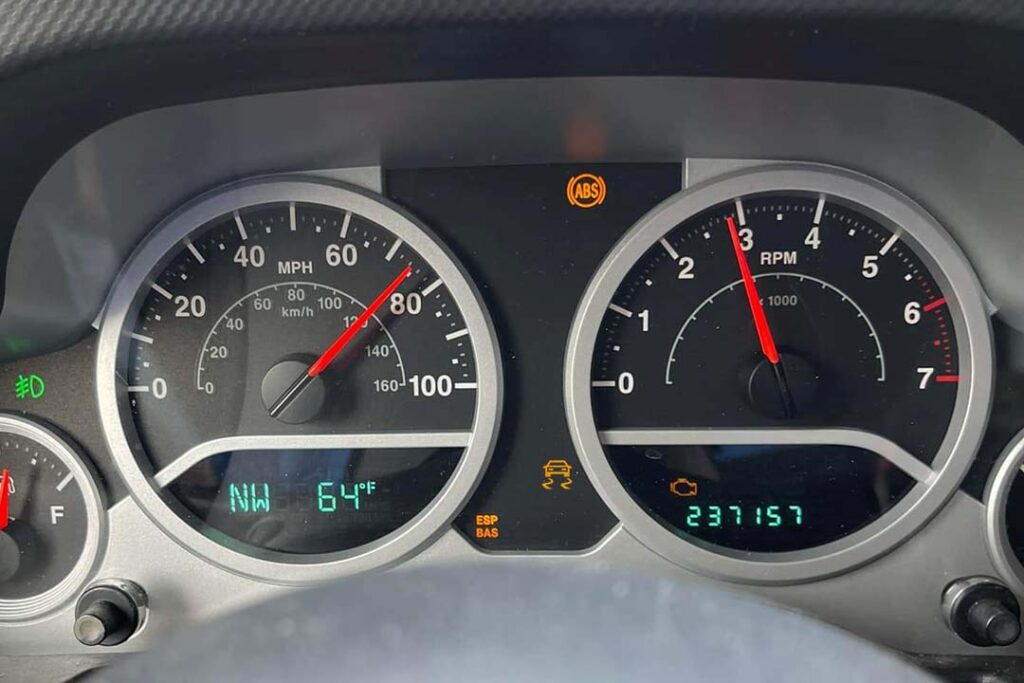ABS, ESP, BAS, And Traction Control Lights On? Learn 6 Causes And Their Fixes!
An unexpected warning light on your Jeep can disrupt your journey. It becomes concerning if four warning lights like the ABS, ESP, BAS, and Traction lights are on.
All these lights coming on together can trigger a sense of uncertainty. I am telling you that they are all connected.
The ABS, ESP, BAS, and Traction lights come on primarily because of a faulty wheel speed sensor. If you replace that sensor, all the lights will go away.
Although sometimes matters are not that simple. Other potential reasons include wiring issues, faulty steering angle sensors, and the failure of the ABS module. But you need to troubleshoot to know for sure.

I’ll explain the underlying causes that lead to the illumination of these lights and the practical solutions to turn off these lights and keep your Jeep running smoothly.
Table of Contents
What Are the Functions of the ABS, ESP, BAS, and Traction Control Indicator Lights in a Jeep Vehicle?
ABS
The ABS (Anti-Lock Braking System) light in your Jeep serves a vital function related to vehicle safety.
It is usually yellow, amber, or orange when illuminated during the system check at engine startup. It signals that the ABS is operational.
As you brake, the ABS keeps your wheels from locking up. It provides steering control in scenarios where one wheel turns slower than the others, indicating a potential loss of control.
ABS intervenes through wheel-speed sensors by modulating brake force. It allows the outlier wheel to spin and restores driver control.
ESP & BAS
The ESP (Electronic Stability Program) and BAS (Brake Assist System) lights indicate potential issues with these safety features.
The ESP enhances driver control in adverse conditions, such as slippery roads, aiding in traction and steering.
The BAS works in conjunction with the ABS. It intensifies brake pressure during emergencies for optimal braking performance.
If the ESP BAS light is on constantly under normal driving conditions, it suggests a fault within these systems.
TCS
The Traction Control light is often represented by a flashing triangle in your Jeep.
TCS, closely linked with the ABS, monitors the steering and stability of the vehicle.
In conditions where wheel spin is detected, such as on snowy or icy surfaces, the Traction Control System intervenes by modulating brake force through the shared wheel-speed sensors.
This prevents tire slip during acceleration, enhancing overall vehicle stability.
Why Are the ABS, ESP, BAS, and Traction Control Lights on in Your Jeep, and How Can You Fix Them?
The reasons your ABS, ESP, BAS, and Traction control lights are on your dashboard, along with solutions, are listed below:
1. Bad Wheel Speed Sensor
If your Jeep’s ABS, ESP, BAS, and Traction lights are on, most likely, a wheel speed sensor is misbehaving.
These sensors measure how fast each wheel is spinning. However, like all things electrical, they can go bad.
Sometimes, the sensors detect wheels spinning at different speeds. This can trigger the ESP BAS light, indicating a loss of traction.
Sensors can get dirty or damaged, giving incorrect readings. The traction control system gets confused if it can’t accurately tell how fast your wheels are moving.
You can also damage your sensor while replacing the strut.
If your ABS, ESP, BAS, and Traction lights are always on, inspect those wheel speed sensors.
If they’re not reading well, replacing them is the solution.
Put in new ones, and your Jeep should regain its equilibrium.
Rust can become a factor, too. Check that the sensors are not corroded. Clean off any rust to avoid intermittent signals.
Fortunately, these sensors are usually easy to access. Jack up your vehicle, remove the wheel and swap out the defective sensor.
But how will you know if your wheel speed sensor has become faulty?
When the ABS, ESP, BAS, and Traction lights come on, the most straightforward way to pinpoint the issue is by reading the trouble codes stored using an OBDII scanner.
It interfaces with the vehicle’s Engine Control Module (ECM). This provides access to trouble codes that reveal the specific problem.
For those without an OBDII scan tool in their toolkit, worry not. Many auto parts stores offer a complimentary scanning service. Take advantage of this service to retrieve the trouble codes.
2. Broken, Stretched, or Crushed Wires
If your Jeep’s wheel speed sensors are fine, the culprit may lurk within the web of wires connecting various sensors and the ABS control module.
While it’s not a common issue in newer models due to enhanced wiring protection, bad luck or wear and tear can still play a role.
The wires to the wheel speed sensors, typically attached to the wheels, can get damaged.
Communication between the sensors and the ABS control module may be hampered as a result. Hence, it triggers the ABS, ESP, BAS, and Traction control light.
Wiring problems, especially those related to grounds, can be elusive.
Corroded or compromised grounds, often crimped onto eye-loop connectors, may seem fine but can wreak havoc on various electrical components. Leading to random issues like headlight malfunctioning or traction control problems.
For example, a notorious three-wire splice behind the driver’s sidekick panel can corrode, causing connectivity issues. This elusive problem can be tricky to detect without experience.
Look for any evidence of damage on the wires that are attached to the wheel speed sensors.
If you find broken, stretched, or crushed wires, consider repairing or replacing them to ensure smooth communication between sensors and the ABS control module.
If you suspect ground issues, inspect the crimped-on eye-loop connectors. These can deceive with a hidden break in the copper wire.
Cut off compromised eye loops and reattach quality ones for a reliable ground connection.
Conduct a thorough inspection behind the driver’s sidekick panel for the elusive three-wire splice. If corrosion is detected, address it promptly.
3. Faulty Steering Angle Sensor
If your Jeep’s ABS, ESP, BAS, and Traction lights are on, another probable cause is a faulty steering angle sensor.
This component is crucial for keeping your steering wheel in sync with your wheels. If it becomes faulty, it can be concerning.
The steering angle sensor may lose contact due to a poor connection or outright failure. These issues trigger the ABS, ESP, BAS, and Traction lights on your dashboard.
A faulty steering angle sensor may send incorrect signals to your wheels, leading to a disconnection between your steering wheel and tires.
This mismatch can disrupt the harmony between steering inputs and actual wheel movement.
If the ABS, ESP, BAS, and Traction lights remain on, it can indicate an inoperative steering angle sensor. If the sensor is irreparably damaged, you need to replace it.
Unplug the battery and remove the airbag. Using a socket and ratchet, replace the faulty sensor. After the replacement, you must recalibrate for the ABS, ESP, BAS, and Traction light to disappear.
4. Not Calibrated Steering Angle Sensor
If your Jeep’s ABS, ESP, BAS, and Traction lights are persistently lit, your steering angle sensor may not be properly calibrated.
An uncalibrated steering angle sensor can lead to misalignment between your steering inputs and the actual movement of the wheels.
This difference triggers the lights on your dashboard. It signals a need for calibration.
Fortunately, you can recalibrate the steering angle sensor, often without special tools.
Sit in the driver’s seat and gently turn the steering wheel to your right. Turn two times until it locks.
Then, turn to the left. Turn two times until it locks. Then return to the center.
This simple action can help realign the sensor with the wheels. Additionally, you may need to cycle the key for the calibration to take effect.
For a more technical approach, you can use an OBD-II scanner to recalibrate the steering angle sensor.
Connect the scanner, read the codes, and initiate recalibration as needed. This method ensures a precise realignment of the sensor for accurate readings.
5. Bad ABS Module
Sometimes, your ABS module can malfunction, causing the ABS, ESP, BAS, and Traction lights to come on.
A single control module often powers both the ABS and TCS.
A problem with the ABS module can trigger warning lights for both systems, indicating a shared malfunction. This failure can result from various issues within the module.
If the ABS module is identified as the source of the problem, replacement is often necessary. Perform a comprehensive diagnostic to determine the underlying cause of the ABS module malfunction.
Once diagnosed, address the specific problem and undertake repairs accordingly.
6. Shot Wheel Bearing
Wear and tear, or sometimes corrosion can take the life out of a wheel bearing.
A deteriorating wheel bearing can lead to misreading the wheel speed in the wheel hub. As the bearing wears, the wheel speed sensor may struggle to measure wheel revolutions accurately. Giving the Electronic Control Module (ECM) erroneous signals.
This can trigger a cascade effect, influencing other sensors like those responsible for ESP/BAS (Traction Control), leading to illuminating warning lights on the dashboard.
If you identify the issue as a shot wheel bearing, I recommend replacing it.
If you install a new wheel bearing, it’ll restore the proper functioning of the ABS sensor. You’ll get accurate readings and prevent false signals from reaching the ECM.
When replacing the wheel bearing, conduct a comprehensive inspection of the surrounding components, including the ABS sensor.
Ensure there are no damages or issues that may affect its performance. Address any additional concerns to prevent future malfunctions.
Also Read: Service Electronic Stability Control Jeep Warning: 9 Tips to Fix the Issue

Is It Safe to Drive With ABS, ESP, BAS, and Traction Lights On?
Driving with the ABS, ESP, BAS, and Traction lights on is not safe.
The constant illumination of the ESP BAS light indicates a system fault. It means advanced safety features are disabled. Losing them due to a faulty ESP BAS system is a significant safety compromise.
The lights signify potential loss of control, especially in adverse weather. Disregarding this warning and continuing to drive with the ESP BAS light on puts both you and others at risk.
For the ABS and Traction Control lights, driving is unsafe when both indicators, along with the red brake warning light, are illuminated simultaneously.
Seek a safe place to pull over, restart the vehicle, and if the lights persist, do not continue driving.
Consult a mechanic for a comprehensive system diagnosis. In urgent situations, drive gently, avoiding hard braking or acceleration to prevent wheel slippage.
Read More: Why Is My Jeep Wrangler Blower Motor Not Working? – 7 Easy Fixes
Final Words
ESP and BAS are integral safety features you’ll find in nearly every Jeep. When the ESP BAS light illuminates and persists on your instrument cluster, it signals potential issues within these safety mechanisms.
If the ABS and Traction Control lights also come on, it’s often a sign that the vehicle’s computer has detected a malfunction or issues like faulty wheel sensors, wiring issues, or malfunctioning steering angle sensors.
Don’t worry. The braking system should still function, but you should slow down and apply moderate braking to avoid wheel slippage. Have an OBDII scanner, pull the trouble codes, identify triggers, and solve them to reset the ABS, ESP, BAS, and Traction light.
